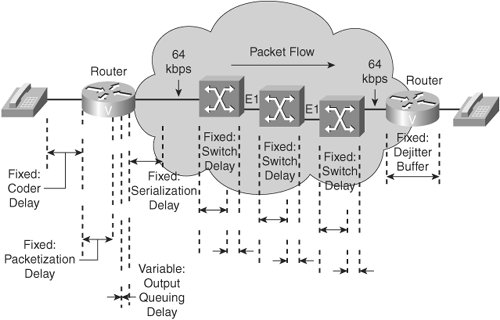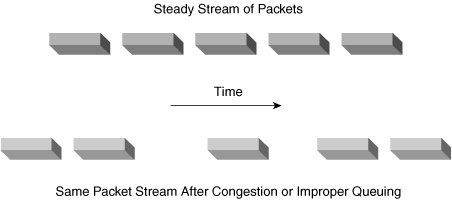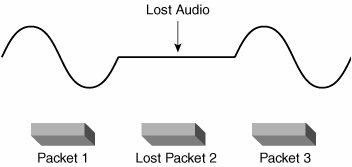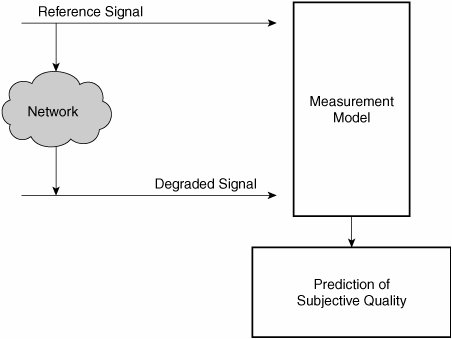Optimizing Voice Quality
| Because of the inherent characteristics of a converged voice and data IP network, administrators face certain challenges in delivering voice traffic correctly. This section describes these challenges and offers solutions for avoiding and overcoming them when designing a VoIP network for optimal voice quality. Factors that Affect Voice QualityBecause of the nature of IP networking, voice packets sent via IP are subject to certain transmission problems. Conditions present in the network might introduce problems such as echo, jitter, or delay. These problems must be addressed with QoS mechanisms. The clarity, or cleanliness and crispness, of the audio signal is of utmost importance. The listener must be able to recognize the speaker's identity and sense the mood of the speaker. These factors can affect clarity:
Although each of the preceding factors affects audio clarity, factors that present the greatest challenges to VoIP networks include jitter, delay, and packet drops. A lack of network bandwidth is usually the underlying cause for these issues, which are addressed in the following sections. JitterJitter is defined as a variation in the delay of received packets, as illustrated in Figure 7-1. On the sending side, packets are sent in a continuous stream with the packets spaced evenly. Because of network congestion, improper queuing, or configuration errors, this steady stream can become uneven, because the delay between each packet varies instead of remaining constant. Figure 7-1. Jitter in IP Networks When a router receives a VoIP audio stream, it must compensate for the jitter that is encountered. The mechanism that handles this function is the playout delay buffer, or dejitter buffer. The playout delay buffer must buffer these packets and then play them out in a steady stream to the digital signal processors (DSPs) to be converted back to an analog audio stream. The playout delay buffer, however, affects the overall absolute delay. When a conversation is subjected to jitter, the results can be clearly heard. If the talker says, "Watson, come here. I want you," the listener might hear "Wat....s...on.......come here, I......wa......nt........y......ou." The variable arrival of the packets at the receiving end causes the speech to be delayed and garbled. DelayOverall or absolute delay can affect VoIP. You might have experienced delay in a telephone conversation with someone on a different continent. The delays can cause entire words in the conversation to be cut off, and can therefore be very frustrating. When you design a network that transports voice over packet, frame, or cell infrastructures, it is important to understand and account for the predictable delay components in the network. You must also correctly account for all potential delays to ensure that overall network performance is acceptable. Overall voice quality is a function of many factors, including the compression algorithm, errors and frame loss, echo cancellation, and delay. Figure 7-2 shows various sources and types of delay. Notice that there are two distinct types of delay:
Figure 7-2. Sources of Delay Acceptable DelayThe ITU specifies network delay for voice applications in Recommendation G.114. This recommendation defines three bands of one-way delay, as shown in Table 7.1.
Note This recommendation is for connections where echo is adequately controlled, implying that echo cancellers are used. Echo cancellers are required when one-way delay exceeds 25 ms (G.131). This G.114 recommendation is oriented toward national telecommunications administrations and therefore is more stringent than recommendations that would normally be applied in private voice networks. When the location and business needs of end users are well known to a network designer, more delay might prove acceptable. For private networks, a 200 ms delay is a reasonable goal and a 250 ms delay is a limit. This goal is what Cisco proposes as reasonable, as long as excessive jitter does not impact voice quality. However, all networks must be engineered so that the maximum expected voice connection delay is known and minimized. The G.114 recommendation is for one-way delay only and does not account for round-trip delay. Network design engineers must consider both variable and fixed delays in their design. Variable delays include queuing and network delays, while fixed delays include coding, packetization, serialization, and dejitter buffer delays. Table 7.2 provides an example of a delay budget calculation.
Packet LossLost data packets, as depicted in Figure 7-3 are recoverable if the endpoints can request retransmission. However, lost voice packets are not recoverable, because the audio must be played out in real time and retransmission is not an option. Figure 7-3. Packet Loss Voice packets might be dropped under the following conditions:
Packet loss causes voice clipping and skips. As a result, the listener hears gaps in the conversation. The industry-standard coder-decoder (CODEC) algorithms used in Cisco DSPs correct for 2050 ms of lost voice through the use of Packet Loss Concealment (PLC) algorithms. PLC intelligently analyzes missing packets and generates a reasonable replacement packet to improve the voice quality. Cisco VoIP technology uses 20 ms samples of voice payload per VoIP packet by default. Effective CODEC correction algorithms require that only a single packet can be lost at any given time. If more packets are lost, the listener experiences gaps. If a conversation experiences packet loss, the effect is immediately heard. If the talker says, "Watson, come here. I want you," the listener might hear, "Wat...., come here, ......you." Quality MetricsQuality must be measurable in order to be manageable. Three quality metrics include the Mean Opinion Score (MOS), the Perceptual Speech Quality Measurement (PSQM), and the Perceptual Evaluation of Speech Quality (PESQ). MOSMOS is a scoring system for voice quality. An MOS score is generated when listeners evaluate prerecorded sentences that are subject to varying conditions, such as compression algorithms. Listeners then assign the sentences values, based on a scale from 1 to 5, where 1 is the worst and 5 is the best. The sentence used for English language MOS testing is, "Nowadays, a chicken leg is a rare dish." This sentence is used because it contains a wide range of sounds found in human speech, such as long vowels, short vowels, hard sounds, and soft sounds. The test scores are then averaged to a composite score. The test results are subjective because they are based on the opinions of the listeners. The tests are also relative, because a score of 3.8 from one test cannot be directly compared to a score of 3.8 from another test. Therefore, a baseline needs to be established for all tests, such as G.711, so that the scores can be normalized and compared directly. PSQMPSQM is an automated method of measuring speech quality "in service," or as the speech happens. PSQM software usually resides with IP call-management systems, which are sometimes integrated into Simple Network Management Protocol (SNMP) systems. Equipment and software that can measure PSQM is available through third-party vendors but is not implemented in Cisco devices. The PSQM measurement is made by comparing the original transmitted speech to the resulting speech at the far end of the transmission channel. PSQM systems are deployed as in-service components. The PSQM measurements are made during real conversation on the network. This automated testing algorithm has over 90 percent accuracy compared to subjective listening tests, such as MOS. Scoring is based on a scale from 0 to 6.5, where 0 is the best and 6.5 is the worst. Because it was originally designed for circuit-switched voice, PSQM does not take into account the jitter or delay problems that are experienced in packet-switched voice systems. PESQMOS and PSQM are not recommended for present-day VoIP networks. Both were originally designed before the emergence of VoIP technologies and do not measure typical VoIP problems such as jitter and delay. For example, it is possible to obtain an MOS score of 3.8 on a VoIP network when the one-way delay exceeds 500 ms, because the MOS evaluator has no concept of a two-way conversation and listens only to audio quality. The one-way delay is not evaluated. PESQ, whose operation is illustrated in Figure 7-4, was originally developed by British Telecom, Psytechnics, and KPN Research of the Netherlands. It has evolved into ITU Standard P.862, which is considered the current standard for voice quality measurement. PESQ can take into account CODEC errors, filtering errors, jitter problems, and delay problems that are typical in a VoIP network. PESQ combines the best of the PSQM method along with a method called Perceptual Analysis Measurement System (PAMS). PESQ scores range from 1 (worst) to 4.5 (best), with 3.8 considered "toll quality" (that is, acceptable quality in a traditional telephony network). PESQ is meant to measure only one aspect of voice quality. The effects of two-way communication, such as loudness loss, delay, echo, and sidetone, are not reflected in PESQ scores. Figure 7-4. PESQ Many equipment vendors offer PESQ measurement systems. Such systems are either stand-alone or they plug into existing network management systems. PESQ was designed to mirror the MOS measurement system. So, if a score of 3.2 is measured by PESQ, a score of 3.2 should be achieved using MOS methods. Quality Measurement ComparisonEarly quality measurement methods, such as MOS and PSQM, were designed before widespread acceptance of VoIP technology. PESQ was designed to address the shortcomings of MOS and PSQM. MOS uses subjective testing where the average opinion of a group of test users is calculated to create the MOS score. This method is both time-consuming and expensive, and might not provide consistent results between groups of testers. PSQM and PESQ use objective testing where an original reference file sent into the system is compared with the impaired signal that came out. This testing method provides an automated test mechanism that does not rely on human interpretation for result calculations. However, PSQM was originally designed for circuit-switched networks and does not take into account the effects of jitter and packet loss. PESQ measures the effect of end-to-end network conditions, including CODEC processing, jitter, and packet loss. Therefore, PESQ is the preferred method of testing voice quality in an IP network. Table 7.3 offers a comparison of the various quality metrics.
Objectives of QoSTo ensure that VoIP is an acceptable replacement for standard public switched telephone network (PSTN) telephony services, customers must receive the same consistently high quality of voice transmission that they receive with basic telephone services. Like other real-time applications, VoIP is extremely sensitive to issues related to bandwidth and delay. To ensure that VoIP transmissions are intelligible to the receiver, voice packets cannot be dropped, excessively delayed, or subjected to variations in delay (that is, jitter). VoIP guarantees high-quality voice transmission only if the signaling and audio channel packets have priority over other kinds of network traffic. A successful VoIP deployment must provide an acceptable level of voice quality by meeting VoIP traffic requirements for issues related to bandwidth, latency, and jitter. QoS provides better, more predictable network service by performing the following:
Cisco routers support multiple QoS mechanisms that can be leveraged to accomplish the objectives listed in the preceding bullet points. The following sections detail specific QoS mechanisms and caution against poor design characteristics. Using QoS to Improve Voice QualityVoice features that provide QoS are deployed at different points in the network and are designed for use with other QoS features to achieve specific goals, such as minimization of jitter and delay. Cisco IOS includes a complete set of features for delivering QoS throughout the network. Following are a few examples of Cisco IOS features that address the voice packet delivery requirements of end-to-end QoS and service differentiation:
Recognizing Common Design FaultsSuccessful implementations of delay-sensitive applications such as VoIP require a network that is carefully engineered with QoS from end to end. Fine-tuning the network to adequately support VoIP involves a series of protocols and features geared toward improving voice quality. QoS is the ability of a network to provide better service levels to selected network traffic over various underlying technologies. However, QoS is not inherent in a network infrastructure. Instead, QoS is implemented by strategically enabling appropriate QoS features throughout the network. Poor design is characterized by the following issues:
Many people believe that the fastest way to fix network performance is simply to add a lot of bandwidth. That approach might work well in certain situations like campus networks, in which upgrading from 10 Mbps to 100 Mbps or even 1 GB links might be possible. However, it is not always feasible to add bandwidth in a WAN. Upgrading a WAN circuit from 56 kbps to T1 might be cost prohibitive and might not be possible for certain locations on the network. To provide effective performance in a voice network, you should configure QoS throughout the network, not just on the devices running VoIP. Not all QoS techniques are appropriate for all network routers. Edge routers and backbone routers in a network do not necessarily perform the same operations. The QoS tasks these routers perform might differ as well. To configure an IP network for real-time voice traffic, you should consider the functions of both edge and backbone routers and select the appropriate QoS tools accordingly. |
EAN: 2147483647
Pages: 111


